A New Gold(III) Complex, TGS 703, Shows Potent Anti-Inflammatory Activity in Colitis via the Enzymatic and Non-Enzymatic Antioxidant System—An In Vitro, In Silico, and In Vivo Study
Abstract
1. Introduction
2. Results
2.1. TGS Complexes Showed an Anti-Inflammatory Profile In Vitro in RAW264.7 Macrophages
2.2. Molecular Modeling Suggests Higher Pharmacological Activity and Stability of Complexes TGS 701, 702, and 703 over TGS 404 and 512
2.3. TGS 703 Attenuated Colitis in DSS-Induced Mouse Model
2.4. TGS 703 Influenced the Antioxidant Profile in the Mouse Colon
3. Discussion
4. Materials and Methods
4.1. Synthesis of Novel Gold(III) Complexes

4.2. Molecular Modeling
4.3. Cell Line Culture
4.4. Cytotoxicity Assessment
4.5. Griess Assay
4.6. Animals
4.7. Induction of Colitis
4.8. Pharmacological Treatment
4.9. Microscopic Score and Colonic Damage Evaluation
4.10. Determination of Tissue Myeloperoxidase Activity
4.11. Statistical Analysis
5. Conclusions
Supplementary Materials
Author Contributions
Funding
Institutional Review Board Statement
Informed Consent Statement
Data Availability Statement
Conflicts of Interest
References
- Wang, H.H.; Su, C.H.; Wu, Y.J.; Lin, C.A.J.; Lee, C.H.; Shen, J.L.; Chan, W.H.; Chang, W.H.; Yeh, H.I. Application of Gold in Biomedicine: Past, Present and Future. Int. J. Gerontol. 2012, 6, 1–4. [Google Scholar] [CrossRef]
- Moustakas, M.; Dendrinou-Samara, C.; Milan, J.; Niemczyk, K.; Kus-Li, M. Treasure on the Earth—Gold Nanoparticles and Their Biomedical Applications. Materials 2022, 15, 3355. [Google Scholar] [CrossRef]
- Yeo, C.I.; Ooi, K.K.; Tiekink, E.R.T. Gold-Based Medicine: A Paradigm Shift in Anti-Cancer Therapy? Molecules 2018, 23, 1410. [Google Scholar] [CrossRef]
- Ko, W.-C.; Wang, S.-J.; Hsiao, C.-Y.; Hung, C.-T.; Hsu, Y.-J.; Chang, D.-C.; Hung, C.-F.; Ko, W.-C.; Wang, S.-J.; Hsiao, C.-Y.; et al. Pharmacological Role of Functionalized Gold Nanoparticles in Disease Applications. Molecules 2022, 27, 1551. [Google Scholar] [CrossRef]
- Wang, Z.; Cao, Y.; Zhang, K.; Guo, Z.; Liu, Y.; Zhou, P.; Liu, Z.; Lu, X. Gold Nanoparticles Alleviates the Lipopolysaccharide-Induced Intestinal Epithelial Barrier Dysfunction. Bioengineered 2021, 12, 6472–6483. [Google Scholar] [CrossRef]
- Fujita, T.; Zysman, M.; Elgrabli, D.; Murayama, T.; Haruta, M.; Lanone, S.; Ishida, T.; Boczkowski, J. Anti-Inflammatory Effect of Gold Nanoparticles Supported on Metal Oxides. Sci. Rep. 2021, 11, 23129. [Google Scholar] [CrossRef] [PubMed]
- Krajewska, J.B.; Włodarczyk, J.; Jacenik, D.; Kordek, R.; Taciak, P.; Szczepaniak, R.; Fichna, J. New Class of Anti-Inflammatory Therapeutics Based on Gold (III) Complexes in Intestinal Inflammation-Proof of Concept Based on In Vitro and In Vivo Studies. Int. J. Mol. Sci. 2021, 22, 3121. [Google Scholar] [CrossRef] [PubMed]
- Lipiec, S.; Gurba, A.; Agnieszczak, I.M.; Szczepankiewicz, A.A.; Szymański, P.; Taciak, P.; Szczepaniak, R.; Szeleszczuk, Ł.; Nieznanska, H.; Włodarczyk, J.; et al. New Gold (III) Cyanide Complex TGS121 Induces ER Stress, Proteasome Inhibition and Death of Ras-Hyperactivated Cells. Toxicol. In Vitro 2023, 88, 105556. [Google Scholar] [CrossRef] [PubMed]
- Ohkoshi, S.-I.; Namai, A.; Tokoro, H. Humidity Sensitivity, Organic Molecule Sensitivity, and Superionic Conductivity on Porous Magnets Based on Cyano-Bridged Bimetal Assemblies. Coord Chem. Rev. 2019, 380, 572–583. [Google Scholar] [CrossRef]
- Rayón, V.M.; Redondo, P.; Valdês, H.; Barrientos, C.; Largo, A. Cyanides and Isocyanides of First-Row Transition Metals: Molecular Structure, Bonding, and Isomerization Barriers. J. Phys. Chem. A 2007, 111, 6334–6344. [Google Scholar] [CrossRef] [PubMed]
- Sipos, G.; Drinkel, E.E.; Dorta, R. The Emergence of Sulfoxides as Efficient Ligands in Transition Metal Catalysis. Chem. Soc. Rev. 2015, 44, 3834–3860. [Google Scholar] [CrossRef]
- Cardoso, B.D.P.; Royo, B.; Calhorda, M.J. Preference for Sulfoxide S- or O-Bonding to 3d Transition Metals—DFT Insights. J. Organomet. Chem. 2015, 792, 167–176. [Google Scholar] [CrossRef]
- Siah, S.Y.; Leung, P.H.; Mok, K.F. Palladium(II) and Platinum(II) Complexes with a Novel P–S(O)–P Tridentate Ligand. Polyhedron 1994, 13, 3253–3255. [Google Scholar] [CrossRef]
- Michalík, M.; Lukeš, V. The Validation of Quantum Chemical Lipophilicity Prediction of Alcohols. Acta Chim. Slovaca 2016, 9, 89–94. [Google Scholar] [CrossRef]
- Garrido, N.M.; Economou, I.G.; Queimada, A.J.; Jorge, M.; Macedo, E.A. Prediction of the N-Hexane/Water and 1-Octanol/Water Partition Coefficients for Environmentally Relevant Compounds Using Molecular Simulation. AIChE J. 2012, 58, 1929–1938. [Google Scholar] [CrossRef]
- Tesauro, D. Metal Complexes in Diagnosis and Therapy. Int. J. Mol. Sci. 2022, 23, 4377. [Google Scholar] [CrossRef]
- Tolbatov, I.; Marrone, A.; Coletti, C.; Re, N. Computational Studies of Au(I) and Au(III) Anticancer MetalLodrugs: A Survey. Molecules 2021, 26, 7600. [Google Scholar] [CrossRef]
- Sonzogni-Desautels, K.; Ndao, M. Will Auranofin Become a Golden New Treatment Against COVID-19? Front. Immunol. 2021, 12. [Google Scholar] [CrossRef] [PubMed]
- Madeira, J.M.; Gibson, D.L.; Kean, W.F.; Klegeris, A. The Biological Activity of Auranofin: Implications for Novel Treatment of Diseases. Inflammopharmacology 2012, 20, 297–306. [Google Scholar] [CrossRef] [PubMed]
- Facchinetti, M.M. Heme-Oxygenase-1. Antioxid. Redox Signal. 2020, 32, 1239–1242. [Google Scholar] [CrossRef] [PubMed]
- Ryter, S.W.; Alam, J.; Choi, A.M.K. Heme Oxygenase-1/Carbon Monoxide: From Basic Science to Therapeutic Applications. Physiol. Rev. 2006, 86, 583–650. [Google Scholar] [CrossRef] [PubMed]
- Fige, É.; Szendrei, J.; Sós, L.; Kraszewska, I.; Potor, L.; Balla, J.; Szondy, Z. Heme Oxygenase-1 Contributes to Both the Engulfment and the Anti-Inflammatory Program of Macrophages during Efferocytosis. Cells 2021, 10, 652. [Google Scholar] [CrossRef] [PubMed]
- Takagi, T.; Naito, Y.; Mizushima, K.; Hirai, Y.; Harusato, A.; Okayama, T.; Katada, K.; Kamada, K.; Uchiyama, K.; Handa, O.; et al. Heme Oxygenase-1 Prevents Murine Intestinal Inflammation. J. Clin. Biochem. Nutr. 2018, 63, 169. [Google Scholar] [CrossRef] [PubMed]
- Zhang, L.; Zhang, Y.; Zhong, W.; Di, C.; Lin, X.; Xia, Z. Heme Oxygenase-1 Ameliorates Dextran Sulfate Sodium-Induced Acute Murine Colitis by Regulating Th17/Treg Cell Balance. J. Biol. Chem. 2014, 289, 26847. [Google Scholar] [CrossRef] [PubMed]
- Bai, A.; Lu, N.; Guo, Y.; Liu, Z.; Chen, J.; Peng, Z. All-Trans Retinoic Acid down-Regulates Inflammatory Responses by Shifting the Treg/Th17 Profile in Human Ulcerative and Murine Colitis. J. Leukoc. Biol. 2009, 86, 959–969. [Google Scholar] [CrossRef]
- Eastaff-Leung, N.; Mabarrack, N.; Barbour, A.; Cummins, A.; Barry, S. Foxp3+ Regulatory T Cells, Th17 Effector Cells, and Cytokine Environment in Inflammatory Bowel Disease. J. Clin. Immunol. 2010, 30, 80–89. [Google Scholar] [CrossRef]
- Goyal, M.M.; Basak, A. Human Catalase: Looking for Complete Identity. Protein Cell 2010, 1, 888. [Google Scholar] [CrossRef]
- Kim, D.H.; Park, J.; Kim, S.; Yoon, M.Y.; Ma, H.W.; Park, I.S.; Son, M.; Kim, J.H.; Kim, T.I.; Kim, W.H.; et al. An Escherichia Coli Strain with Extra Catalase Activity Protects against Murine Colitis by Scavenging Hydrogen Peroxide and Regulating Regulatory t Cell/Interleukin-17 Pathways. Free Radic. Biol. Med. 2021, 174, 110–120. [Google Scholar] [CrossRef]
- Haddad, J.J.; Harb, H.L. L-γ-Glutamyl-l-Cysteinyl-Glycine (Glutathione; GSH) and GSH-Related Enzymes in the Regulation of pro- and Anti-Inflammatory Cytokines: A Signaling Transcriptional Scenario for Redox(y) Immunologic Sensor(s)? Mol. Immunol. 2005, 42, 987–1014. [Google Scholar] [CrossRef]
- Elmaksoud, H.A.A.; Motawea, M.H.; Desoky, A.A.; Elharrif, M.G.; Ibrahimi, A. Hydroxytyrosol Alleviate Intestinal Inflammation, Oxidative Stress and Apoptosis Resulted in Ulcerative Colitis. Biomed. Pharmacother. 2021, 142, 112073. [Google Scholar] [CrossRef]
- Vassilyadi, P.; Harding, S.V.; Nitschmann, E.; Wykes, L.J. Experimental Colitis and Malnutrition Differentially Affect the Metabolism of Glutathione and Related Sulfhydryl Metabolites in Different Tissues. Eur. J. Nutr. 2016, 55, 1769–1776. [Google Scholar] [CrossRef] [PubMed]
- Wang, L.; Han, R.; Zang, K.; Yuan, P.; Qin, H. Deficiency in Glutathione Synthesis and Reduction Contributes to the Pathogenesis of Colitis-Related Liver Injury. Zhong Nan Da Xue Xue Bao Yi Xue Ban 2022, 47, 271–279. [Google Scholar] [CrossRef] [PubMed]
- Peng, X.; Li, J.; Tan, S.; Xu, M.; Tao, J.; Jiang, J.; Liu, H.; Wu, B. COX-1/PGE2/EP4 Alleviates Mucosal Injury by Upregulating β-Arr1-Mediated Akt Signaling in Colitis. Sci. Rep. 2017, 7, 7055. [Google Scholar] [CrossRef] [PubMed]
- Sakamoto, C. Roles of COX-1 and COX-2 in Gastrointestinal Pathophysiology. J. Gastroenterol. 1998, 33, 618–624. [Google Scholar] [CrossRef]
- Kepp, K.P. Benchmarking Density Functionals for Chemical Bonds of Gold. J. Phys. Chem. A 2017, 121, 2022–2034. [Google Scholar] [CrossRef]
- Barone, V.; Cossi, M.; Tomasi, J. A New Definition of Cavities for the Computation of Solvation Free Energies by the Polarizable Continuum Model. J. Chem. Phys. 1998, 107, 3210. [Google Scholar] [CrossRef]


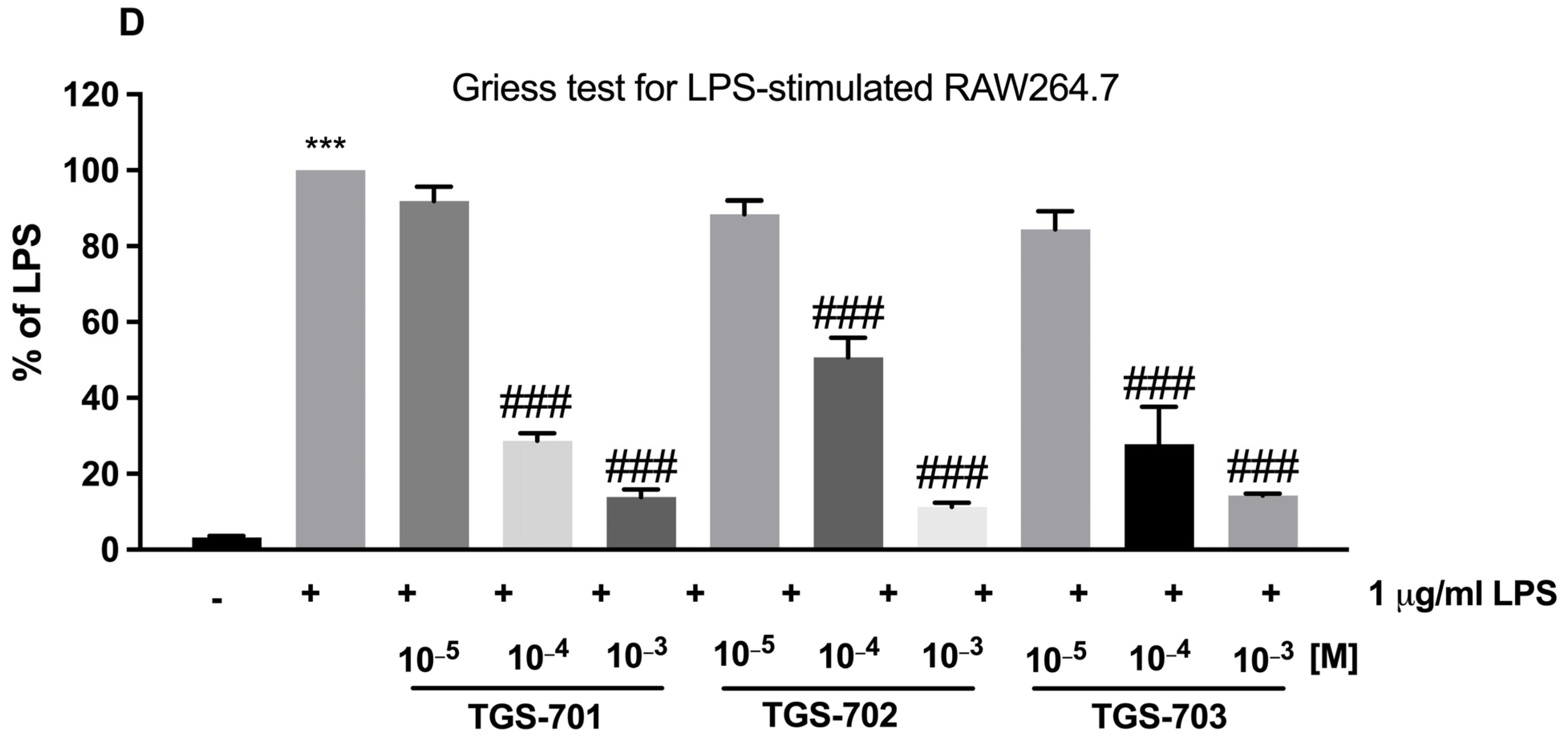
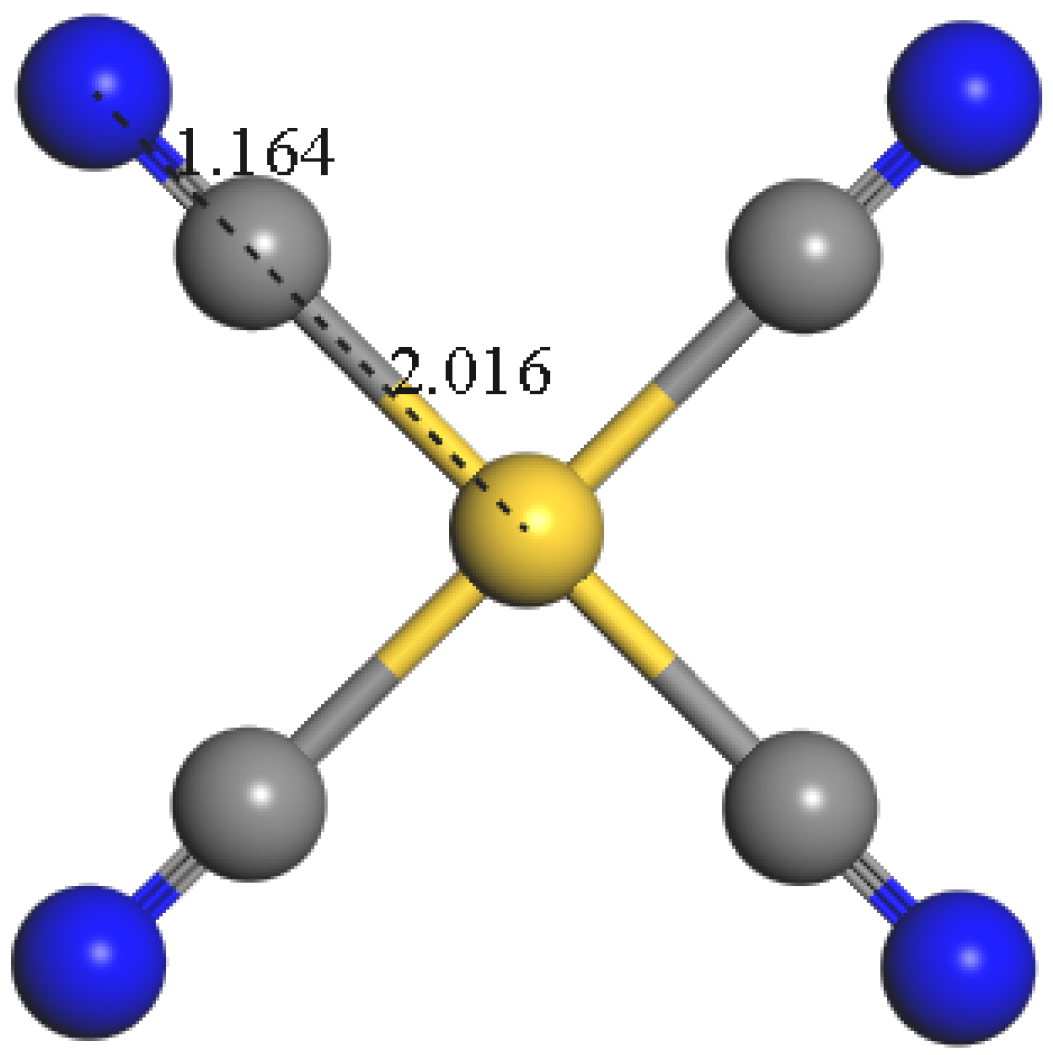
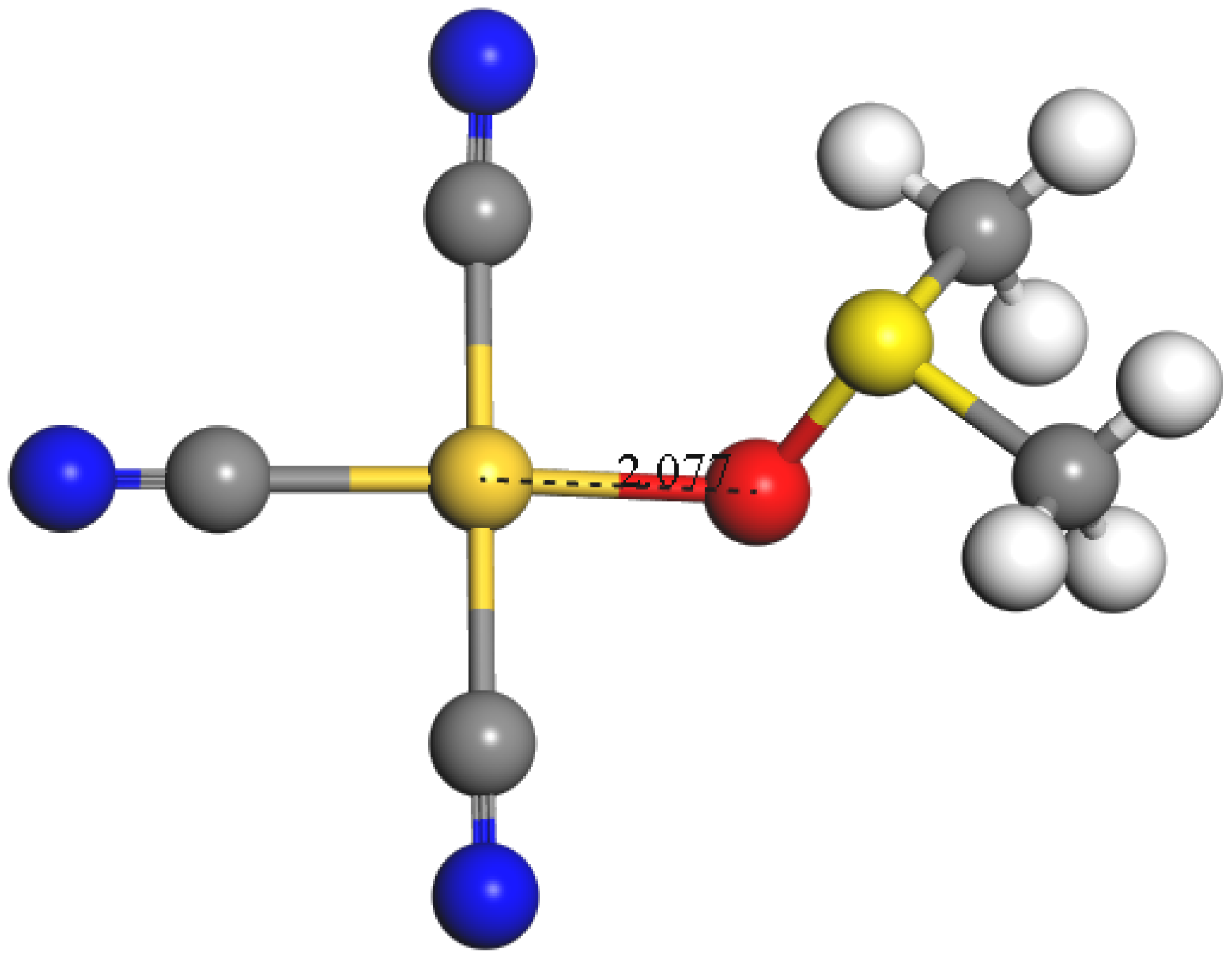





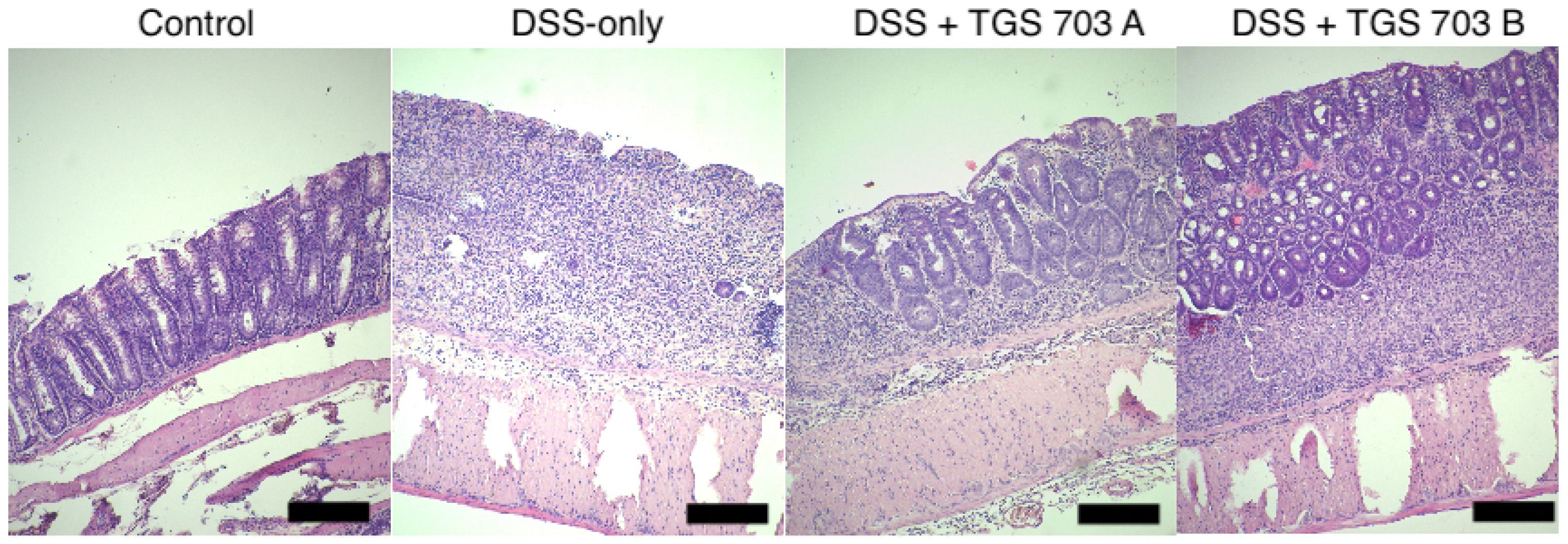
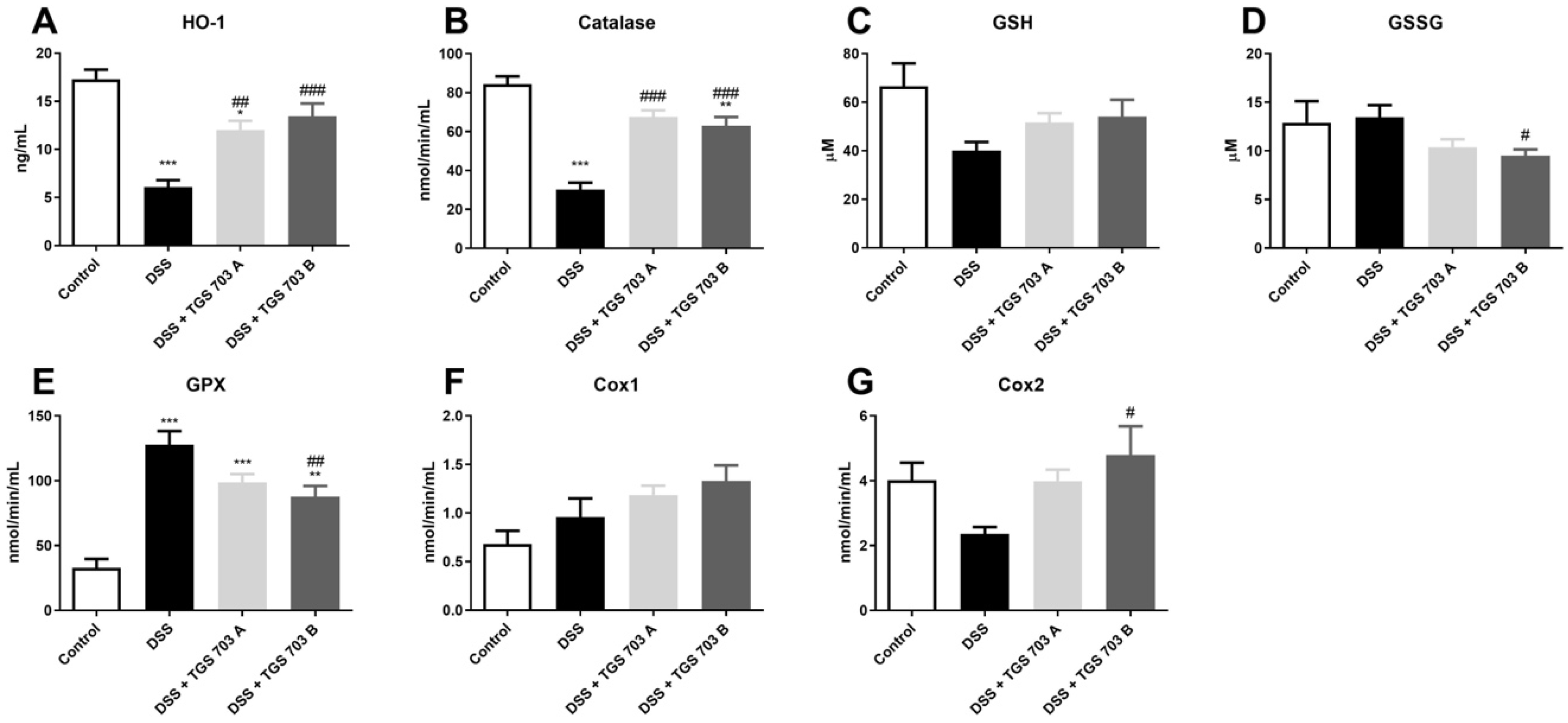
| Au(CN)4− | ||
|---|---|---|
| E | In vacuo | −1539.48 |
| Water | −493.08 | |
| DMSO | −502.14 | |
| E + ZPVE | In vacuo | −1531.36 |
| Water | −485.17 | |
| DMSO | −494.21 | |
| ΔG | In vacuo | −1495.58 |
| Water | −449.70 | |
| DMSO | −458.74 |
| Au(CN)4− | Au(CN)3(NC)− | Au(CN)2(NC)2− NS | Au(CN)2(NC)2− S | Au(NC)3CN− | Au(NC)4− | ||
|---|---|---|---|---|---|---|---|
| E | In vacuo | 0.00 | 17.05 | 33.36 | 37.08 | 52.65 | 71.26 |
| Water | 0.00 | 17.25 | 33.77 | 37.71 | 53.48 | 72.50 | |
| DMSO | 0.00 | 17.25 | 33.77 | 37.68 | 53.47 | 72.48 | |
| E + ZPVE | In vacuo | 0.00 | 16.69 | 32.64 | 36.33 | 51.55 | 69.73 |
| Water | 0.00 | 17.06 | 33.19 | 37.14 | 52.58 | 71.13 | |
| DMSO | 0.00 | 17.06 | 33.18 | 37.13 | 52.57 | 71.13 | |
| ΔG | In vacuo | 0.00 | 16.56 | 32.39 | 36.07 | 51.17 | 69.16 |
| Water | 0.00 | 17.20 | 33.11 | 37.17 | 52.52 | 70.81 | |
| DMSO | 0.00 | 17.20 | 33.10 | 37.21 | 52.51 | 70.84 |
| [Au(CN)3DMSO] κ-S | [Au(CN)3DMSO] κ-O | [Au(CN)3DMSO] κ-S | [Au(CN)3DMSO] κ-O | |
|---|---|---|---|---|
| DMSO | In Vacuo | |||
| E | 34.42 | 34.20 | 73.20 | 72.77 |
| E + ZPVE | 34.32 | 33.71 | 118.19 | 72.07 |
| ΔG | 37.04 | 35.69 | 120.51 | 73.82 |
| [Au(CN)4DMSO]− κ-S | [Au(CN)4DMSO]− κ-O | [Au(CN)4DMSO]− κ-S | [Au(CN)4DMSO]− κ-O | |
|---|---|---|---|---|
| DMSO | In Vacuo | |||
| E | −4.96 | −5.24 | −10.15 | −4.89 |
| E + ZPVE | −4.39 | −4.73 | −9.53 | −4.43 |
| ΔG | 4.26 | 6.20 | 0.03 | 5.54 |
| [Au(CN)4DMSO2]− κ-S,S | [Au(CN)4DMSO2]− κ-S,O | [Au(CN)4DMSO2]− κ-O,O | [Au(CN)4DMSO2]− κ-S,S | [Au(CN)4DMSO2]− κ-S,O | [Au(CN)4DMSO2]− κ-O,O | |
|---|---|---|---|---|---|---|
| DMSO | In Vacuo | |||||
| E | −10.07 | −0.08 | −10.01 | −20.56 | −14.85 | −15.45 |
| E + ZPVE | −9.00 | 0.03 | −8.89 | −19.28 | −14.02 | −14.39 |
| ΔG | 9.81 | 19.33 | 10.54 | −0.05 | 7.29 | 5.03 |
| [Au(CN)3H2O] | [Au(CN)3H2O] | |
|---|---|---|
| Water | In Vacuo | |
| E | 46.11 | 87.02 |
| E + ZPVE | 47.19 | 87.67 |
| ΔG | 46.70 | 86.96 |
| [Au(CN)4H2O]− | [Au(CN)4(H2O)2]− | [Au(CN)4H2O]− | [Au(CN)4(H2O)2]− | |
|---|---|---|---|---|
| Water | In Vacuo | |||
| E | −2.06 | −7.55 | −1.36 | −1.75 |
| E + ZPVE | −1.37 | −5.20 | −0.90 | −1.08 |
| ΔG | 5.80 | 11.07 | 7.33 | 13.44 |
| ΔGwater | ΔGoctanol | logPOW |
|---|---|---|
| −46.12 | −41.40 | 3.46 |
Disclaimer/Publisher’s Note: The statements, opinions and data contained in all publications are solely those of the individual author(s) and contributor(s) and not of MDPI and/or the editor(s). MDPI and/or the editor(s) disclaim responsibility for any injury to people or property resulting from any ideas, methods, instructions or products referred to in the content. |
© 2023 by the authors. Licensee MDPI, Basel, Switzerland. This article is an open access article distributed under the terms and conditions of the Creative Commons Attribution (CC BY) license (https://creativecommons.org/licenses/by/4.0/).
Share and Cite
Włodarczyk, J.; Krajewska, J.; Szeleszczuk, Ł.; Szałwińska, P.; Gurba, A.; Lipiec, S.; Taciak, P.; Szczepaniak, R.; Mlynarczuk-Bialy, I.; Fichna, J. A New Gold(III) Complex, TGS 703, Shows Potent Anti-Inflammatory Activity in Colitis via the Enzymatic and Non-Enzymatic Antioxidant System—An In Vitro, In Silico, and In Vivo Study. Int. J. Mol. Sci. 2023, 24, 7025. https://doi.org/10.3390/ijms24087025
Włodarczyk J, Krajewska J, Szeleszczuk Ł, Szałwińska P, Gurba A, Lipiec S, Taciak P, Szczepaniak R, Mlynarczuk-Bialy I, Fichna J. A New Gold(III) Complex, TGS 703, Shows Potent Anti-Inflammatory Activity in Colitis via the Enzymatic and Non-Enzymatic Antioxidant System—An In Vitro, In Silico, and In Vivo Study. International Journal of Molecular Sciences. 2023; 24(8):7025. https://doi.org/10.3390/ijms24087025
Chicago/Turabian StyleWłodarczyk, Jakub, Julia Krajewska, Łukasz Szeleszczuk, Patrycja Szałwińska, Agata Gurba, Szymon Lipiec, Przemysław Taciak, Remigiusz Szczepaniak, Izabela Mlynarczuk-Bialy, and Jakub Fichna. 2023. "A New Gold(III) Complex, TGS 703, Shows Potent Anti-Inflammatory Activity in Colitis via the Enzymatic and Non-Enzymatic Antioxidant System—An In Vitro, In Silico, and In Vivo Study" International Journal of Molecular Sciences 24, no. 8: 7025. https://doi.org/10.3390/ijms24087025
APA StyleWłodarczyk, J., Krajewska, J., Szeleszczuk, Ł., Szałwińska, P., Gurba, A., Lipiec, S., Taciak, P., Szczepaniak, R., Mlynarczuk-Bialy, I., & Fichna, J. (2023). A New Gold(III) Complex, TGS 703, Shows Potent Anti-Inflammatory Activity in Colitis via the Enzymatic and Non-Enzymatic Antioxidant System—An In Vitro, In Silico, and In Vivo Study. International Journal of Molecular Sciences, 24(8), 7025. https://doi.org/10.3390/ijms24087025








